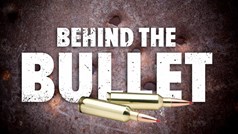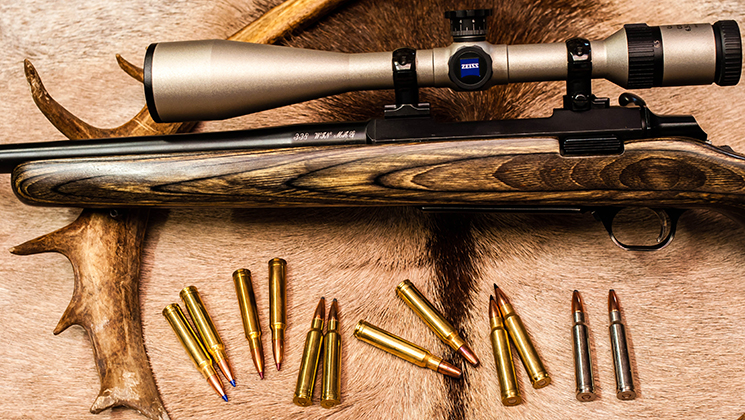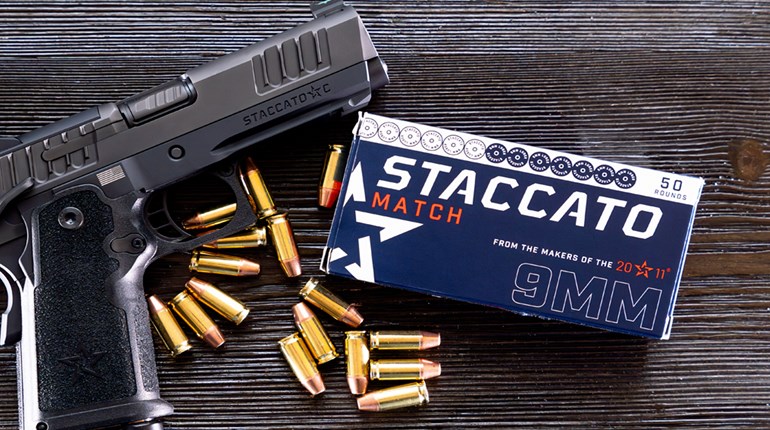
Winchester’s mid-1950s endeavor into developing cartridges started a whirlwind; though Roy Weatherby had been experimenting with the shortened and modified H&H Belted cases, few companies had the clout and marketing power that Winchester did. The Winchester engineers had shortened the .375 H&H case to 2.500”, and necked it either up or down to hold .458”, .338” and .264” diameter bullets, releasing the trio of new magnums in 1958. The .458” and .264” bore diameters were certainly no strangers to the hunting and shooting community; those bore diameters date back to the latter-half of the 19th century in the guise of the .45-70 Government, .450 Nitro Express and 6.5x55 Swedish Mauser and 6.5x54 Mannlicher-Schoenauer.
 But the .338” bullet diameter? That was a carry-over from the older, rimmed .33 Winchester cartridge, which was chambered in the 1886 Winchester rifle, only to be unseated by the .348 Winchester in the uber-cool Model 71 lever gun. I’d suspect that Winchester was geared up to produce .338” caliber bullets, and it just made sense to mate that bore diameter with the modified belted case. The impetus for the cartridge can be traced back to the wildcatting efforts of Charles O’Neil, Elmer Keith and Don Hopkins, who together mated the .30-06 Springfield case and a shortened .375 H&H case with the .333” diameter bullets used in the .333 Jeffery case, resulting in the .333 OKH and .334 OKH, respectively. The .333 bore—which used bullet weights up to 300-grains—had a stellar reputation for penetration among African hunters, and the .333 received the accolades of hunter/writers like John ‘Pondoro’ Taylor.
But the .338” bullet diameter? That was a carry-over from the older, rimmed .33 Winchester cartridge, which was chambered in the 1886 Winchester rifle, only to be unseated by the .348 Winchester in the uber-cool Model 71 lever gun. I’d suspect that Winchester was geared up to produce .338” caliber bullets, and it just made sense to mate that bore diameter with the modified belted case. The impetus for the cartridge can be traced back to the wildcatting efforts of Charles O’Neil, Elmer Keith and Don Hopkins, who together mated the .30-06 Springfield case and a shortened .375 H&H case with the .333” diameter bullets used in the .333 Jeffery case, resulting in the .333 OKH and .334 OKH, respectively. The .333 bore—which used bullet weights up to 300-grains—had a stellar reputation for penetration among African hunters, and the .333 received the accolades of hunter/writers like John ‘Pondoro’ Taylor.
What Winchester did in 1958, was to provide those hunters who pursued the great bears and larger cervids of North America with a perfect choice for their endeavors, as well as developing one the most logical choices for an African light rifle. The original loadings featured 200, 250 and 300-grain bullets, all at respectable muzzle velocities, and offering a ballistic answer to the gap that existed between the .30-06 Sprg./.300 H&H Mag. and the .375 H&H Mag., in a high-quality, affordable American bolt gun.
The heavier slugs made the reputation of the .338 Winchester, as the bullet du jour was a cup-and-core affair, yet as bullet technology improved, the shift to bullets of lighter weight was on. The 300-grain load became unpopular, yet the 250-grain bullet offered a fantastic balance of striking power and trajectory. The 250—delivered at a muzzle velocity of 2,600 to 2,650 fps—gives plenty of power for brown and grizzly bears, as well as making a good choice for any of the larger African antelope species like kudu, sable and eland. This load became the darling of elk hunters in the west, and grizzly hunters across the continent. Delivering over 3,800 ft.-lbs. of energy at the muzzle, this is a serious combination, and comes with a recoil level that can pose an issue when fired from benchrest positions. With a Sectional Density figure of 0.313, those 250-grain bullets will offer excellent penetration, even on the biggest animals.
The lighter bullets bring out the versatility of the .338 Win. Mag.; it’s a very flexible cartridge that can be used on lighter game as well. The 200-grain bullets can be pushed to almost 3,000 fps, and the 225-grain bullets are a good all-around choice, especially if of premium construction. The Federal Premium 225-grain Nosler Partition load can get the job done on just about any animal, anywhere. If you want to extend the trajectory of the .338, bullets like the 210-grain Swift Scirocco will fly very well, due to the boat tail and sleek ogive, yet the thick jacket and bonded-core will hold together on tough shoulder bones. There are some truly light-for-caliber offerings—like the 185-grain Barnes TTSX—that can turn the hard-hitting .338 into a long-range deer gun. The 275 and 300-grain bullets are still available in component form, should a shooter desire to adopt the heavy-and-slow mentality. With an effective bullet range of 185 to 300 grains, the .338 bore gives any shooter plenty to choose from.
Unlike the .375 H&H, which headspaces off the belt, the .338 Winchester uses its 25-degree shoulder for headspacing; like most of the magnums of this era, the belt is just a carryover, and serves no real purpose. I’ve found the .338 Winchester to be capable of fantastic accuracy, with some factory loads and more than a few handloads printing ½ to ¾ MOA.
In Africa, the .338 mates very well with a .416 Rigby or .404 Jeffery, giving a two-gun battery that can truly do it all. Keith was a man of vision, and the .338 Win. Mag. stands as a testament to his efforts. Though it comes with a bit more recoil than most of the .30 caliber magnums, it most definitely hits harder, and makes a better choice for the large bears of the north. I find it just about perfect for moose. It fits in a standard-length receiver, keeping the costs of manufacturing down when compared to the full-length magnum cartridges. For almost 60 years many hunters and guides have learned to rely on the cartridge, and I believe that trend will continue.

Looking for previous installments of Behind the Bullet? We've got you covered.
• .357 S&W Magnum
• 6.5-284 Norma
• 8x57 Mauser
• .38 Smith & Wesson Special
• 7x57mm Mauser
• 9 mm Luger
• .35 Whelen
• .454 Casull
• .375 H&H Magnum
• .45 Colt
• .22-250 Remington
• 10mm Auto
• .308 Winchester




































